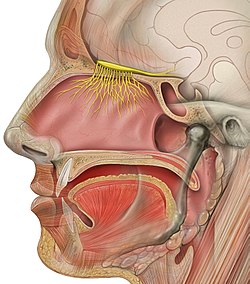Nose: Difference between revisions
| [pending revision] | [pending revision] |
m Reverted 2 edits by 206.130.211.37 identified as vandalism to last revision by 92.2.193.86. using TW |
No edit summary |
||
| Line 1: | Line 1: | ||
{{otheruses}} |
{{otheruses}} |
||
{{Unreferenced|date=June 2008}} |
{{Unreferenced|date=June 2008}} |
||
noses are for picking |
|||
{{for|the article about noses in humans|human nose}} |
{{for|the article about noses in humans|human nose}} |
||
Revision as of 18:16, 3 November 2009
noses are for picking
| Nose | |
|---|---|
 Section throuch human nose with olfactory nerve | |
 Dogs have very sensitive noses | |
| Details | |
| Identifiers | |
| Latin | nause |
| MeSH | D009666 |
| TA98 | A06.1.01.001 A01.1.00.009 |
| TA2 | 117 |
| Anatomical terminology | |
Anatomically, a nose is a protuberance in vertebrates that houses the nostrils, or nares, which admit and expel air for respiration in conjunction with the mouth. Behind the nose is the olfactory mucosa and the sinuses. Behind the nasal cavity, air next passes through the pharynx, shared with the digestive system, and then into the rest of the respiratory system. In humans, the nose is located centrally on the face; on most other mammals, it is on the upper tip of the snout.
In cetaceans, the nose has been reduced to the nostrils, which have migrated to the top of the head, producing a more streamlined body shape and the ability to breathe while mostly submerged. Conversely, the elephant's nose has elaborated into a long, muscular, manipulative organ called the trunk.
Air conditioning

As an interface between the body and the external world, the nose and associated structures frequently perform additional functions concerned with conditioning entering air (for instance, by warming and/or humidifying it, also for flicking if moving and by mostly reclaiming moisture from the air before it is exhaled (as occurs most efficiently in camels). The nose hairs are able to stop unwanted particles from entering the lungs.
Smelling

In most mammals, the nose is the primary large organ for smelling. As the animal sniffs, the air flows through the nose and over structures called turbinates in the nasal cavity. Turbulent flow will promote mixing of the air in the nasal cavity allowing the molecules of a newly inhaled breath of air to reach the sensitive epithelium as fast as possible. Laminar flow would imply a stationary layer of air around the epithelium only to be entered by diffusion. Sniffing will cause more turbulence also. At the olfactory epithelium, odor molecules carried by the air dissolve in the fluid-covered cilia of the olfactory receptor neurons, where they bind to specific receptor proteins causing a depolarization of the receptor cell. At the glomeruli, dendrites of many receptor cells sensitive to the same kind of odor converge and from there a signal is forwarded to the brain's olfactory region.
Sense of direction
The wet nose of dogs is useful for the perception of direction. The sensitive cold receptors in the skin detect the place where the nose is cooled the most and this is the direction a particular smell that the animal just picked up comes from.[1]
See also
- Aquiline nose
- Human nose
- Nasal bridge
- Nose-picking
- Nasal administration
- Rhinarium—the wet, naked surface around the nostrils in most mammals, absent in haplorrhine primates such as humans
- Rhinoplasty
References
- ^ Dijkgraaf S.;Vergelijkende dierfysiologie;Bohn, Scheltema en Holkema, 1978, ISBN 90 313 0322 4
External links
 Media related to nose at Wikimedia Commons
Media related to nose at Wikimedia Commons
